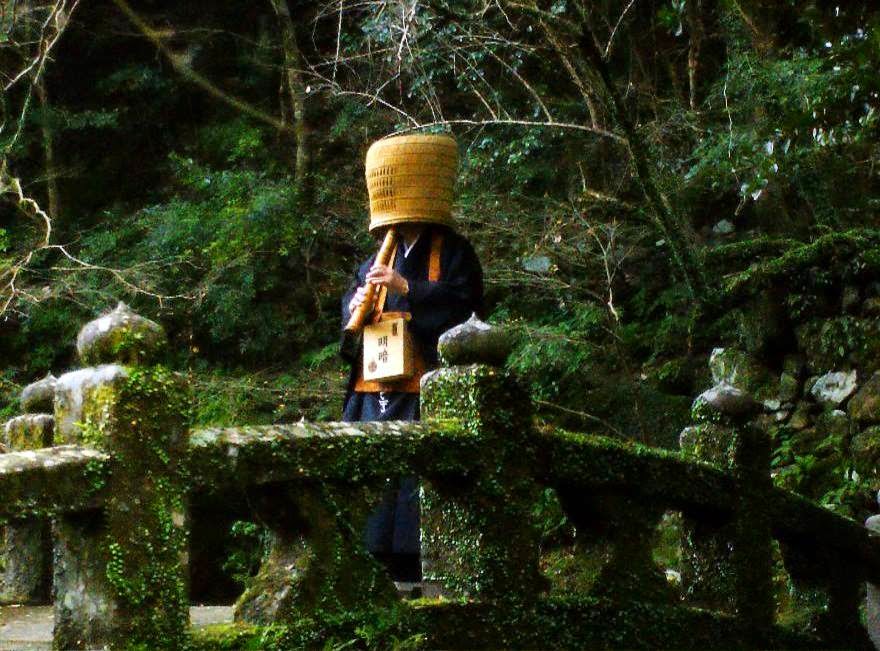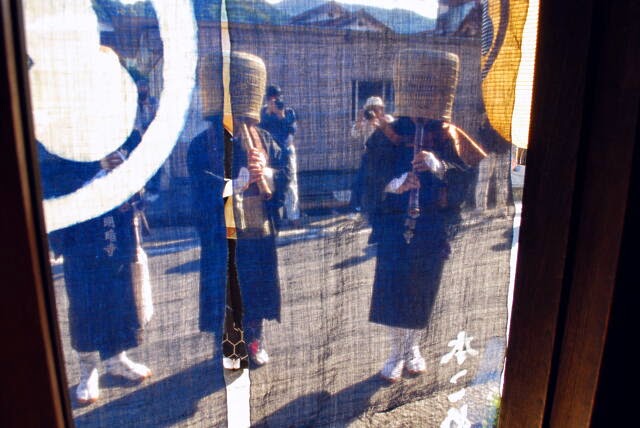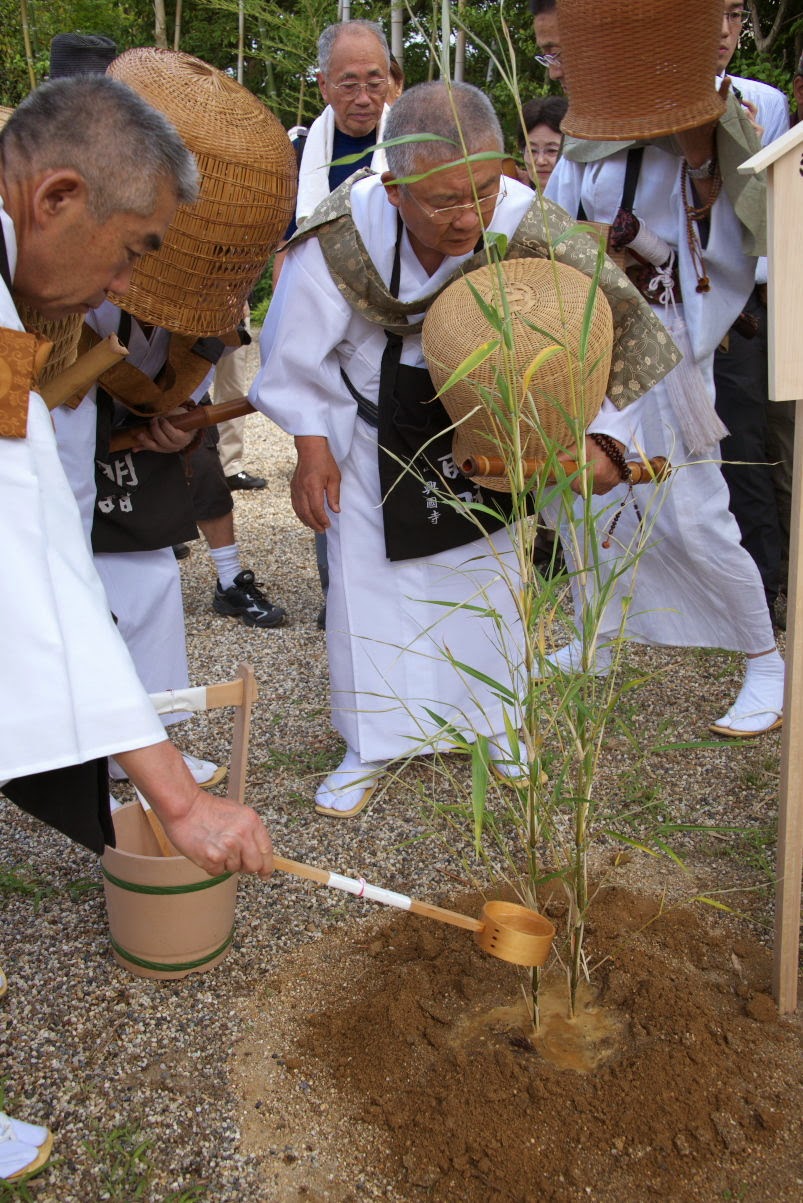Wednesday, December 31, 2014
Sunday, December 28, 2014
Transmission
Friday, December 26, 2014
Okamoto Chikugai; Nezasa-ha and founder of Souryukai
 |
| Okamoto Chikugai's photos of his old school friends |
The Nezasa style of playing comes from Tsugaru at the northern end of Japan. Nezasa was one of the original 16 sub-sects of the Fuke shu. The style is distinguished by its breathy panting vibrato known as komi-buki.
----
According to the historical records of the Nezasa-Ha Kinpu Ryu, its originator was Kesshu Kanga, the chief priest of Enpo-ji temple in Numata, Joshyu, Gumma Prefecture.
From 1784-1836 the main Fuke sect temple "Ichigetsu-ji" had no director. In around the year 1808 Kanga came to Ichigetsu-ji temple from Enpo-ji temple to take over as head director. This took place because Enpo-ji was a branch temple of Ichigetsu-ji.
When Kanga moved to Ichigetsu-ji, Kurihara Einosuke whose Shakuhachi name was "Kinpu" accompanied him. His age at this time is unknown. During this time (1808) the Kinko Ryu pieces were being taught at Ichigetsu-ji by Kinko II and Kinko III (Kinpo). It is said that Kinpu studied the Kinko Ryu pieces diligently and even taught at the temple as a substitute teacher. Kinpu received "Honsoku" (Komuso License) from Kanga.
In the year 1816, Yoshizaki Kodo was officially sent to Ichigetsu-ji from Tsugaru-han (Aomori Prefecture ) to study Shakuhachi. According to the historical records of Takahashi Kuzan and Nui Getsuei, Kodo studied mostly Nezasa-Ha pieces under Kinpu. The reason why he studied mainly the Nezasa-Ha pieces rather than the Kinko pieces is that the third Kinko (Kinpo) died in 1817 (at the age of 45) only a year after Kodo had arrived at Ichigetsu-ji. After the third Kinko there was no appropriate Kinko teacher to take over. Moreover, both Kanga and Kinpu originally belonged to Nezasa-Ha and much preferred to transmit pieces of their own sect rather than to teach the Kinko pieces. Yoshizaki Kodo also preferred to study the Nezasa-Ha pieces because he had once studied similar sounding pieces under "Monai Unrin" in Aomori, his home prefecture. The feudal lord of Tsugarau-han (Aomori Prefecture) also liked the Nezasa-Ha pieces. It was this feudal lord who had sent Kodo to Ichigetsu-ji. In addition to mainly studying the Nezasa-Ha pieces, he learned the 36 Kinko Ryu pieces as well and received "Honsoku" from Kanga with the recommendation of Kinpu in the year 1818. If the chief priest had not been Kanga (who was originally of the Nezasa-Ha) it would have been difficult for Kodo to receive the Kinko Ryu Honsoku because of his having mainly studied the Nezasa-Ha pieces. In the Kinko Ryu Honsoku of Yoshizaki Kodo, Kinpu and his secular name, Kurihara Einosuke was written as a teacher.
After the death of the third Kinko, it was not easy to decide on who should be the fourth Kinko head master (Iemoto). There was a member ot the Kinko family whose name was Kurosawa Otojiro, the younger brother of the third Kinko. However, his Shakuhachi skills and behavior were lacking. At first it seemed that Kinpu would succeed as the new Master, but eventually Kurosawa Otojiro became the fourth Kinko with the assistance of Hisamatsu Fuyo who was an excellent Shakuhachi player. It was too difficult for Kinpu to break the hereditary Kinko Master's post. Also, he was not originally from Ichigetsu-ji.
According to Inoe Shigemi, Kinpu lost face, became a Komuso and left Edo. He wandered as a Komuso in the Tohoku region until his death.
After receiving his Honsoku, Yoshizaki Kodo returned to Tsugaru-han. He once played Kinko Ryu pieces in front of the head of Tsugaru-han according to the records. But after that he only played and taught the Nezasa-Ha pieces for the next 17 years until his death. No one except the head of the Tsugaru-han ever heard Kodo play the Kinko Ryu pieces. Yoshizaki Kodo died in the year 1836 at the age of 38.
The successor of Yoshizaki Kodo was Ban Noriyuki. When Kodo returned to Tsugaru-han (Aomori) Ban Noriyuki was 21 years old. He was a distinguished Shakuhachi player since childhood. He studied with Kinpu (either in Aomori or at Ichigetsu-ji) as well as with Kodo and received Honsoku from Kanga.
It should be noted that Yoshizaki Kodo and Ban Noriyuki were more like brothers in their relationship as students of Kinpu than that Ban Noriyuki was a student of Yoshizaki Kodo. Kodo was only one year older than Noriyuki.
From the time of Ban Noriyuki, the Kinpu Ryu took on the form of a school. It flourished with many good players. Ban Noriyuki died in the year 1894 at the age of 78.
Regarding Nezasa-Ha Kinpu Ryu Successors and the First Iemoto
The Kinpu Ryu consists of the Shakuhachi pieces which were transmitted by the Fuke Shu Nezasa Sect. There are 10 Nezasa-Ha Honkyoku pieces in all. They are:
1.Shirabe
2.Sagari Ha
3.Matsu Kaze
4.Sanya
5.Shishi
6.Nagashi Reibo
7.Tori
8.Kadozuke
9.Hachigaeshi
10.Koku
Regarding the name "Kinpu Ryu" there are various explanations, but it is generally understood that this name came to be used because of the fact that Yoshizaki Kodo who learned Nezasa-Ha Honkyoku pieces under Kurihara Kinpu returned to Aomori and transmitted them. That is why the name Kinpu Ryu came to be used.
Successors:
Kurihara Kinpu (founder)
Yoshizaki Kodo (first successor)
Ban Noriyuki (second successor)
Nui Getsuei (first Iemoto)
Nagano Shoei (second Iemoto)
Narita Shoei (third Iemoto)
Inoe Shoei (fourth Iemoto)
Then Kinpu Ryu was legally established as a Shakuhachi school in the year Meiji 16 (1884) when Nui Getsuei rewrote the Kinpu Ryu Honkyoku pieces, becoming its first Iemoto.
Sunday, November 30, 2014
Saturday, November 22, 2014
Friday, November 14, 2014
Taizan Honkyoku
許 Hirayurushi
1. 一二三調 Hifumi Cho
2. 鉢返曲 Hachigaeshi no Kyoku
3. 瀧落曲 Takiochi no Kyoku
4. 山谷曲 Sanya no Kyoku
5. 九州鈴慕 Kyushu Reibo
6. 志図曲 Shizu no Kyoku
7. 善哉曲 Yoshiya no Kyoku
8. 奥州流 Ohshu Nagashi
初伝 Shoden
9. 秋田曲 Akita no Kyoku
10. 門開曲 Monbiraki no Kyoku
11. 轉菅掻 Koro Sugagaki
12. 吾妻曲 Azuma no Kyoku
中伝 Chuden
13. 戀慕流 Renbo Nagashi
14. 深夜曲 Shinya no Kyoku
15. 巣鶴 Sokaku
16. 雲井曲 Kumoi no Kyoku
奥伝 Okuden
17. 鹿遠音 Shika no Tone
18. 鶴巣籠 Tsuru no Sugomori
19. 榮獅子 Sakae Jishi
別伝 Betsuden
20. 陸奥鈴慕 Mutsu Reibo
21. 打皷曲 Dako no Kyoku
22. 筑紫鈴慕 Chikushi Reibo
23. 鳳叫虚空 Houkyo Koku
24. 龍吟虚空 Ryugin Koku
25. 虎嘯虚空 Koshou Koku
26. 鳳鐸 Houtaku
27. 阿字曲 Aji no Kyoku
28. 曙調 Akebono Shirabe
29. 大和調子 Yamato Choshi
皆伝 Kaiden
30. 調子 Choshi
31. 虚空 (秘曲)Koku
32. 虚鈴 (秘曲) Kyorei
33. 霧海じ(秘曲) Mukaiji
1. 一二三調 Hifumi Cho
2. 鉢返曲 Hachigaeshi no Kyoku
3. 瀧落曲 Takiochi no Kyoku
4. 山谷曲 Sanya no Kyoku
5. 九州鈴慕 Kyushu Reibo
6. 志図曲 Shizu no Kyoku
7. 善哉曲 Yoshiya no Kyoku
8. 奥州流 Ohshu Nagashi
初伝 Shoden
9. 秋田曲 Akita no Kyoku
10. 門開曲 Monbiraki no Kyoku
11. 轉菅掻 Koro Sugagaki
12. 吾妻曲 Azuma no Kyoku
中伝 Chuden
13. 戀慕流 Renbo Nagashi
14. 深夜曲 Shinya no Kyoku
15. 巣鶴 Sokaku
16. 雲井曲 Kumoi no Kyoku
奥伝 Okuden
17. 鹿遠音 Shika no Tone
18. 鶴巣籠 Tsuru no Sugomori
19. 榮獅子 Sakae Jishi
別伝 Betsuden
20. 陸奥鈴慕 Mutsu Reibo
21. 打皷曲 Dako no Kyoku
22. 筑紫鈴慕 Chikushi Reibo
23. 鳳叫虚空 Houkyo Koku
24. 龍吟虚空 Ryugin Koku
25. 虎嘯虚空 Koshou Koku
26. 鳳鐸 Houtaku
27. 阿字曲 Aji no Kyoku
28. 曙調 Akebono Shirabe
29. 大和調子 Yamato Choshi
皆伝 Kaiden
30. 調子 Choshi
31. 虚空 (秘曲)Koku
32. 虚鈴 (秘曲) Kyorei
33. 霧海じ(秘曲) Mukaiji
Sunday, November 2, 2014
Monday, October 20, 2014
Saturday, October 11, 2014
The Sound as Void unmanifest 間
 | ||
| 間
Fujiwara no Yasumasa (958-1036) was a famous musician
at the Heian court. He and his brother, Kidomaru, had parted ways when
Kidomaru became an outlaw rather than serve under the powerful warrior
Raiko. Playing his flute on the lonely moor of Ichihara while walking
home one night, his brother snuck up on
him, intent on robbing him of his elegant robe, but enchanted by
Yasumasa's beautiful music, he stopped in his tracks. Kidomaru instead
followed his brother home, who only then became aware of his presence
and happily gave him a robe. Woodblock print by Tsukioka Yoshitoshi (1832-1892), published 1883.
|
Thursday, October 9, 2014
Monday, October 6, 2014
Saturday, September 20, 2014
Wednesday, September 10, 2014
Sunday, September 7, 2014
Wednesday, August 27, 2014
Sunday, July 27, 2014
Saturday, July 26, 2014
Subscribe to:
Comments (Atom)











































.jpg)





